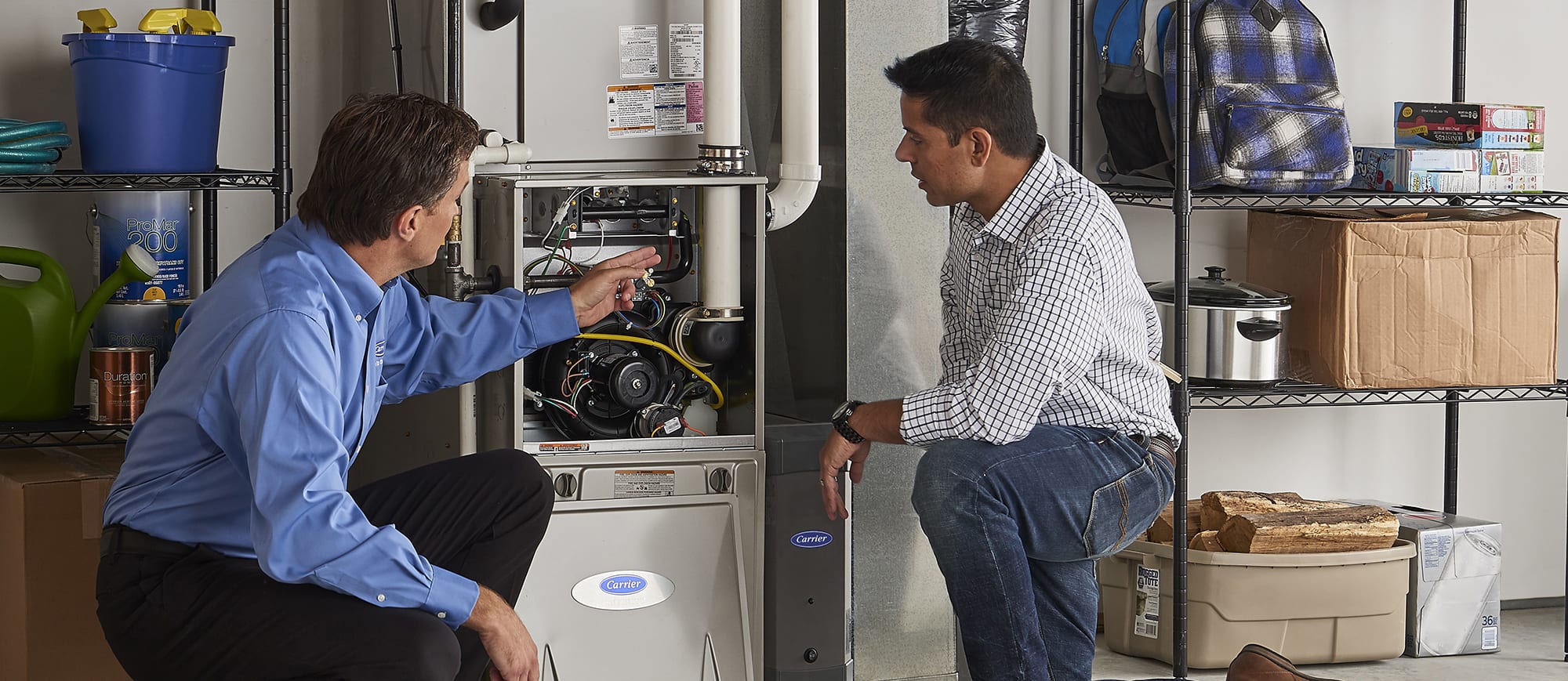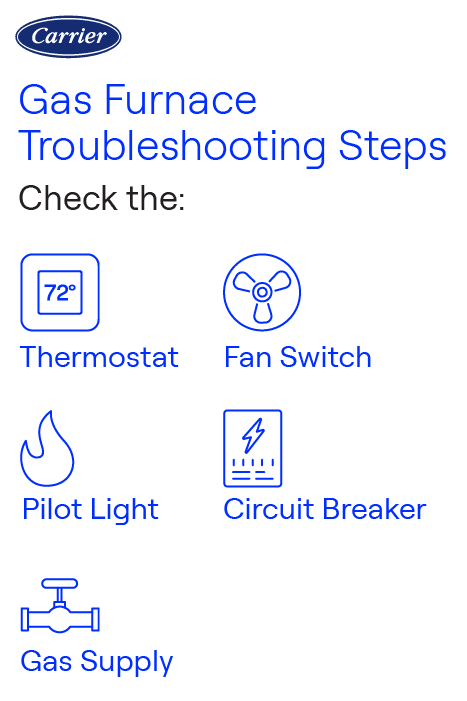Heater Not Working? Try Our Furnace Troubleshooting Guide
What to Do When Your Furnace Isn’t Turning On, Heating, and More
Since the beginning of time, heating has been essential to survival. While it sounds dramatic, there’s a reason why we go to great lengths to make sure our homes are not only secure, but comfortable as well. This is especially true during the heating season, in areas where winter temperatures fall below freezing for extended periods of time. But even in milder areas of the U.S., having a fully functioning heating system you can rely on is a great source of comfort. That’s why troubleshooting a furnace blowing cold air or when it’s not functioning can be an additional source of comfort for you and your family.
The experts at Carrier are here to help get your furnace and HVAC systems back in working order. Not only do we have a complete family of Carrier home furnaces designed to fit your needs, we can help walk you through the basics of how to troubleshoot it when it malfunctions. While you may not be able to complete a full heat exchanger replacement, understanding the content that follows will potentially help you avoid a service call and maybe even prevent a costly furnace repair down the road.

HEATER NOT WORKING? TRY FURNACE TROUBLESHOOTING
As it would with any device or appliance, furnace troubleshooting starts with common sense -- eliminating the easiest and most basic issues. Issues such as “Does it have power?”, “Is the power switch turned on?”, and “Is it set for heating?” This may sound basic, but it is not uncommon for a service technician to come out only to find the system is either not turned on or not set for heating.
Another common issue that can cause a heater not working is an excessively dirty filter. A dirty or clogged filter can seriously restrict heating air flow to the point where the system can’t keep you comfortable. In severe cases it can cause your system to shut down completely. To check your filter, review our page on changing furnace filters or refer to your system’s owner's manual for details.
Kevin Dickson, president of Energy Services Air Conditioning, Heating and Electrical in Naperville, Illinois, summarizes three simple steps a homeowner can take to troubleshoot a furnace.
“When a furnace is not operating, we tell the homeowner to make sure their air filter is clean, confirm the gas supply is on, and verify the power switch to the furnace is turned on,” Dickson said.
GAS FURNACE TROUBLESHOOTING
Most furnaces in the U.S. use natural gas as their fuel source for heating, so we’ll start by focusing on gas furnace troubleshooting. These gas furnace maintenance tips can be applied to propane furnaces as well.
The most common problems with a gas furnace or heater not working that you can evaluate are:
Gas Furnace Not Turning On

- Check the thermostat to ensure it is getting power. Thermostats that aren’t hardwired into your home use batteries that may need to be replaced.
- Check that the thermostat is set correctly to “heat.” If you do not have heat, the thermostat could be set on “off” or “cool.” If this is the case, change it to “heat”.
- Check the temperature setting, sometimes referred to as the “set point.” If your furnace is not running, try adjusting the temperature on the thermostat to be higher than the current room temperature. When the temperature inside your home drops below this setting, your furnace should turn on and run until the temperature inside matches the thermostat’s set point.
- Check that the fan switch is turned to the “on” or “auto” setting. If it’s on “auto,” switch it to “on.” If the furnace fan does not start running after several minutes, you may have an issue with the thermostat, the furnace controls, or you may not have power to the furnace.
- Check the circuit breaker or fuse box to ensure the furnace is getting power and hasn’t tripped a circuit breaker.
- Check the pilot light if you are using an older furnace. If the pilot has gone out, follow your owner’s manual for further instructions.
- Check to ensure that the gas supply is still on. Locate the gas cutoff valve near your furnace. The handle on the gas valve should be parallel to the gas line. However, if you suspect a gas leak or smell gas in your home, do not turn any switches on or off, and do not attempt to relight the pilot light. Get out of your house immediately and call the gas company to come check it.
Air Is Not Hot Enough
- Check the air filter. A clogged filter limits the amount of air that gets through. A dirty filter will likely appear to be gray and possibly have a visible layer dusty buildup.

Gas Furnace Turns Off and On Constantly
- Check the thermostat setting to be sure it is correctly set for “heat” or the fan is set to “on” or “auto”. If the thermostat settings are correct, a furnace that turns on and off constantly can be caused by a system that is not properly sized for the home, a thermostat that is placed too close to a heating source, or a faulty thermostat. These issues may need to be resolved by a professional service technician. Before making that call, be sure to try steps 2 and 3 as described below.
- Check the air filter. A dirty or clogged filter can restrict airflow, which in turn can cause the heat exchanger to overheat.
- Check to ensure room air vents are open and objects are not covering them. If airflow is restricted, your heat exchanger may not be getting enough air, causing your system to turn on and off more often, a situation called “short cycling.”
Gas Furnace Runs Noisily
- Whistling sound—check the air filter to see if it is clogged or excessively dirty.
- Have a loud ignition sound when starting up the furnace? A clogged burner can delay ignition, which causes a loud noise when the gas ignites. This repair requires an expert.
- Whistling or rattling—check for loose connections in the ductwork that can rattle as air flows through.

OIL FURNACE TROUBLESHOOTING
Oil furnace troubleshooting follows a very similar set of procedures as described for gas furnaces. If you are having issues with your oil furnace, the first step should be to check the air filter. If it is dirty or clogged, replace it per the manufacturer’s instructions.
Oil Furnace Won't Turn On
- Check the thermostat to ensure it is getting power. Thermostats that aren’t hardwired into your home use batteries that may need to be replaced.
- Check that the thermostat is correctly set to heat. If you do not have heat, the thermostat could be set on “off” or “cool.” If this is the case, change it to “heat”.
- Check the temperature setting, sometimes referred to as the “set point.” If your furnace is not running, try adjusting the temperature on the thermostat to be higher than the current room temperature. When the temperature inside your home drops below this setting, your furnace should turn on and run until the temperature inside matches the thermostat’s set point.
- Check that the fan switch is turned to the “on” or “auto” setting. If it’s on “auto,” switch it to “on.” If the furnace fan does not start running after several minutes, you may have an issue with the thermostat, the furnace controls, or you may not have power to the furnace.
- Check the circuit breaker or fuse box to ensure the furnace is getting power.
Air Is Not Hot Enough
- Check the air filter. A clogged filter limits the amount of air that gets through. A dirty filter will likely appear to be gray and possibly have a visible layer dusty buildup.
Oil Furnace Turns Off and On Constantly
- Check the thermostat setting to be sure it is correctly set for “heat” or the fan is set to “on” or “auto”. If the thermostat settings are correct, an oil furnace that turns on and off constantly can be caused by a clogged oil filter or burner tip, or a dirty photo cell. A photo cell in an oil furnace checks to be sure there is a flame present before spraying oil into the combustion chamber.
- Check the air filter. A dirty or clogged filter can restrict airflow, which in turn can cause the heat exchanger to overheat, tripping the high limit switch and shutting down the furnace.
- Check to ensure room air vents are open and objects are not covering them. If airflow is restricted, your heat exchanger may not be getting enough air, causing your system to turn on and off more often, a situation called “short cycling.”
Oil Furnace Turns On, then Off
- Check to see if your oil tank is empty. An empty oil tank will cause the system to shut down and require a reset at the primary control.
- If you have fuel oil, you may have a plugged fuel filter or nozzle, and it might be time to contact a professional.
If your oil furnace needs to be replaced, be sure to take a look at the complete family of oil furnaces available from the experts at Carrier.
FURNACE TROUBLESHOOTING NOT WORKING?
While furnace troubleshooting can often result in an easy fix – like replacing a clogged filter – sometimes you have to contact a professional for a complete system check and evaluation. And if you need a major repair like replacing a furnace blower motor or heat exchanger, it may be time to consider the benefits of replacing the entire furnace versus an expensive repair.
Keep in mind that the lifespan of your furnace may vary – most should last a minimum of fifteen years, and longer timeframes aren’t unusual. Other factors to consider would be how well the furnace has been maintained, how many hours it spends heating your home in an average season and how warm you set your thermostat. If you find that you are calling a service technician for repairs every year, it might be time to consider a new furnace. Or, if you find that you are simply changing the furnace filters on a regular schedule and are only experiencing the occasional minor repair, you may have a number of years of reliable operation remaining. Of course, you’ll want to weigh the cost of a new furnace against the cost of continued repairs when making the decision.
FURNACE NOT TURNING ON STILL? CONTACT A PROFESSIONAL

While troubleshooting a forced air furnace might not always reveal a simple solution, all is not lost. Your local Carrier expert is standing by to assist, ready to evaluate your system and provide solutions you can trust. And because your furnace is often tied into a complete heating and cooling system, you’ll benefit from your dealer’s expertise in air conditioners, heat pumps, air purifiers, and other comfort-enhancing accessories as well. Knowing when to call a professional can sometimes be the most important troubleshooting step.
Contact a local Carrier expert to get an estimate for your home today.
Frequently Asked Questions About Furnace Troubleshooting
Heater Not Working? Learn More About Furnaces
- Learn about furnace cleaning
- Discover the signs you need a new furnace
- Learn what to do if you have water dripping from furnace
- Learn about the different parts of a furnace
- Learn about heating repair
- Learn the causes of a furnace not kicking on

